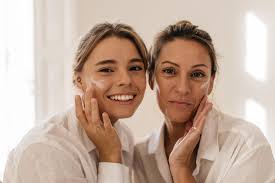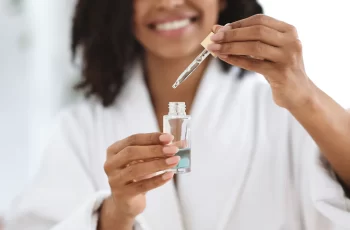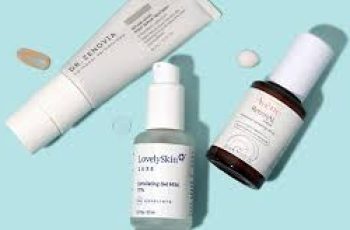Can mandelic acid and niacinamide be used together?
Yes, mandelic acid and niacinamide can be used together, even for people with sensitive skin, to exfoliate and improve skin texture and tone.
What does mandelic acid do to the skin?
Mandelic acid is considered a gentle yet highly effective exfoliant that improves skin tone, texture, and visual appeal. Scientific data shows it can help promote cell turnover, improve skin firmness, and improve discoloration
for a more even, radiant complexion.
Helps even skin tone
Helps reduce discoloration caused by photodamage
Smoothes irregular skin structure
Brighten skin colour
Who should use mandelic acid?
Mandelic acid is great for a variety of skin types, including sensitive skin. Mandelic acid is an effective exfoliant for those with problematic skin and/or issues with skin tone and texture, and is gentler than many other alpha
hydroxy acids due to its large molecular weight.
What does niacinamide do to the skin?
Niacinamide has been shown to improve the overall appearance of skin, reduce discoloration, smooth skin texture, and support the skin’s effectiveness as a protective barrier. Its ability to support ceramide production helps
improve skin firmness while promoting hydration to prevent dehydration. Niacinamide also helps clear clogged pores while balancing oil production.
Niacinamide Benefits
Supports more even skin texture and tone
Visibly helps fade dark spots and other signs of UV-related damage
Helps reduce the appearance of visibly enlarged pores
Helps prevent moisture loss and the effects of environmental stress
Increase charm
Who should use niacinamide?
Niacinamide may benefit people who want to improve their skin tone and texture, including those with sensitive, dry, and/or problem skin. It is ideal for individuals who want to achieve more radiant skin and improve overall
skin health and appearance.
Layered with Mandelic Acid and Niacinamide
Layer products based on their moisture content and consistency. Start with products that are thin and mostly water-based, such as toners, serums, and essences. Next, use thicker products with a higher oil content, such as
lotions, moisturizers, and facial oils. Mandelic acid is both oil- and water-soluble and can be incorporated into any of the above forms. Niacinamide is water-based and is incorporated into water-based products.
As an alpha hydroxy acid, mandelic acid can increase skin sensitivity to sunlight. Therefore, it is crucial to use your daily sunscreen correctly.
How often can mandelic acid and niacinamide be used together?
Mandelic acid and niacinamide can be used together daily. However, it is recommended to start with less frequent use to assess skin tolerance. Start by taking mandelic acid and niacinamide two to three times a week and then
incorporate both medications into your daily routine.
DQH Can I use salicylic acid first and then vitamin C?
It’s easy to create a skincare routine, but knowing how to use it is another thing entirely. In most cases, if you’re not getting the desired skin results, it could be due to the layering of conflicting ingredients. So, is it possible that salicylic acid and vitamin C are such ingredients? Or are these active ingredients the duo that’s been missing from your skincare routine? If you want answers, stick around because today we are going to explain the benefits of salicylic acid and vitamin C and how they can be used in your daily life.
What are the benefits of salicylic acid for skin?
Salicylic acid is one of the most commonly used beta hydroxy acids and is favored by many people with oily, acne-prone skin. This acid is derived from willow bark, and unlike its water-soluble relatives (called alpha-hydroxy acids), salicylic acid is oil-soluble, which means it can penetrate deeper into the lower layers of the skin. Once it reaches the lower layers, it can help unclog pores of excess sebum, dirt, bacteria, debris, and impurities. This results in clearer skin tones and greater definition.
Not only does salicylic acid benefit the underlying layers, but the outer surface of the skin benefits as well. When applied to the skin, salicylic acid removes the buildup of dead skin cells. This is accomplished by breaking the bonds that hold dead cells to the surface. Over time, this can cause the complexion to look dull and prone to acne, blackheads, and other blemishes.
If you’d like to learn more about salicylic acid and how it can improve your skin, check out this dedicated blog post from a beauty insider.
What are the benefits of vitamin C for skin?
Vitamin C is considered one of the most powerful antioxidants, which means it is very effective at fighting free radicals and preventing them from causing further skin damage. Examples of free radicals include pollution, central heating, UV rays and harsh climate. They attack proteins, fats and cell membranes as soon as they come into contact with the skin, causing signs of premature aging such as fine lines and wrinkles as well as hyperpigmentation, flaky patches of skin and loss of elasticity.
Many people usually prefer to use vitamin C in their morning routine as this ingredient gives the complexion a radiant glow. You’ll also find that vitamin C can target areas of hyperpigmentation, plumping the skin and reducing the appearance of fine lines and wrinkles.
The thing about vitamin C is that there are a lot of outdated studies going back to the 1950s that describe vitamin C as an unstable skin component. Thanks to improvements in modern technology, this is no longer the case as all products now contain a stable form of vitamin C.
Visit The Beauty Insider to learn more about vitamin C. So please check out our blog post.
Can I use salicylic acid first and then vitamin C?
Yes, you absolutely can. In fact, it’s thought that using salicylic acid before using vitamin C ensures it penetrates faster and works faster.
This is an efficient way to utilize two power sources, and the reason has to do with pH. For example, the skin’s natural pH is about 4.7, making it slightly acidic. Salicylic acid and vitamin C are also both acidic, and you’ll find that vitamin C is absorbed quickly into the skin. Therefore, using salicylic acid beforehand can increase the acidity of the skin and allow vitamin C to penetrate into the skin faster.
While this is considered an effective way to combine two powerful ingredients, you need to be aware of your skin type and how it reacts to certain active ingredients. Even people with perfect, normal skin can experience skin sensitivity and irritation. Therefore, always consult a doctor or dermatologist before using any new products on your skin.
It’s also important to follow skin application rules. In this case, you need to use the product correctly to ensure you get the best results for your skin. If you’re not sure what I mean, the basic rule for skin is to start with the thinnest consistency and work your way up to the thickest consistency. This prevents a barrier from forming on the surface, preventing other active ingredients from penetrating the skin.
Can I use salicylic acid at night and vitamin C in the morning?
Yes, absolutely, this is considered the most effective way to get returns without any adverse side effects. This is because there is enough time between applications to ensure that the skin’s pH levels return to balance.
You’ll also find that Vitamin C is rich in antioxidants and is perfect for use in the morning to ensure your skin is protected and looking its healthiest. Due to the small size of salicylic acid molecules, it is an acid that is able to reach the deepest parts of the skin. While this is effective at keeping skin clear, it also increases the risk of irritation and photosensitivity. Therefore, many people prefer to use powerful BHAs in their evening routine without exposure to UV rays, pollution, or harsh weather.
Warning: If you avoid using sunscreen every day, none of these ingredients will do what your skin needs. The combination of chemical peels and powerful ingredients increases the risk of further damage to the skin’s surface. Use SPF 50 every day to keep your skin protected and your lipid barrier healthy, even on cloudy days, keeping your skin in top condition.



